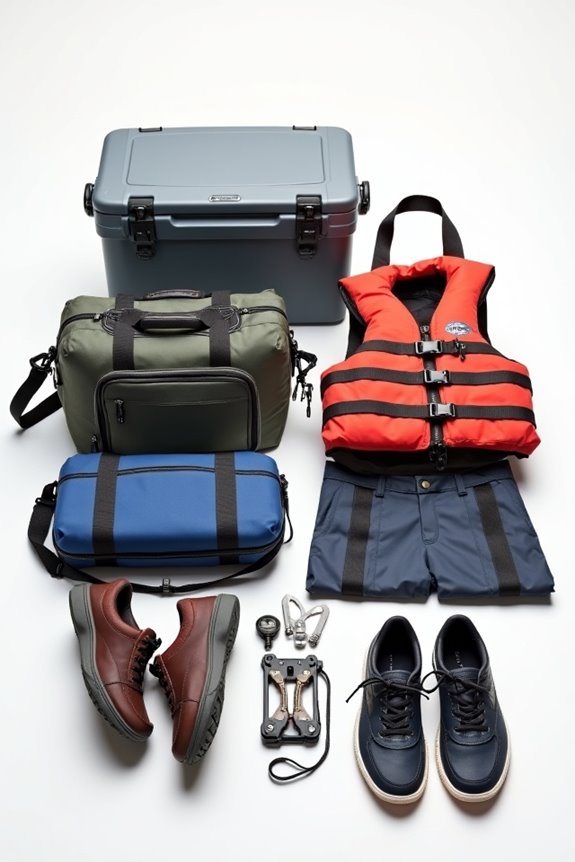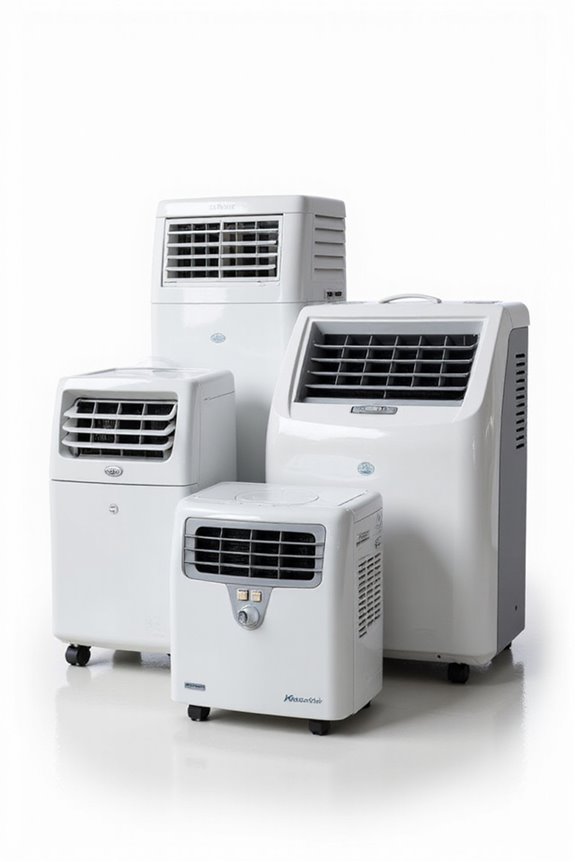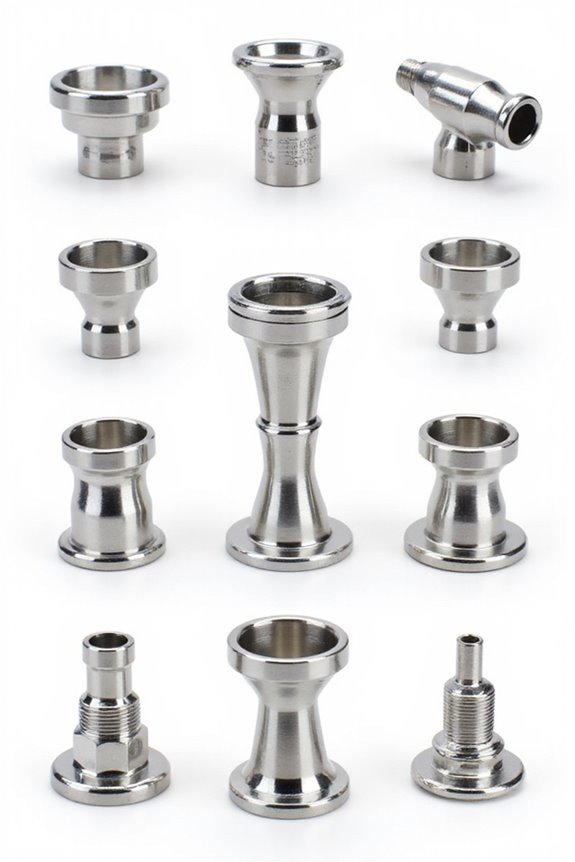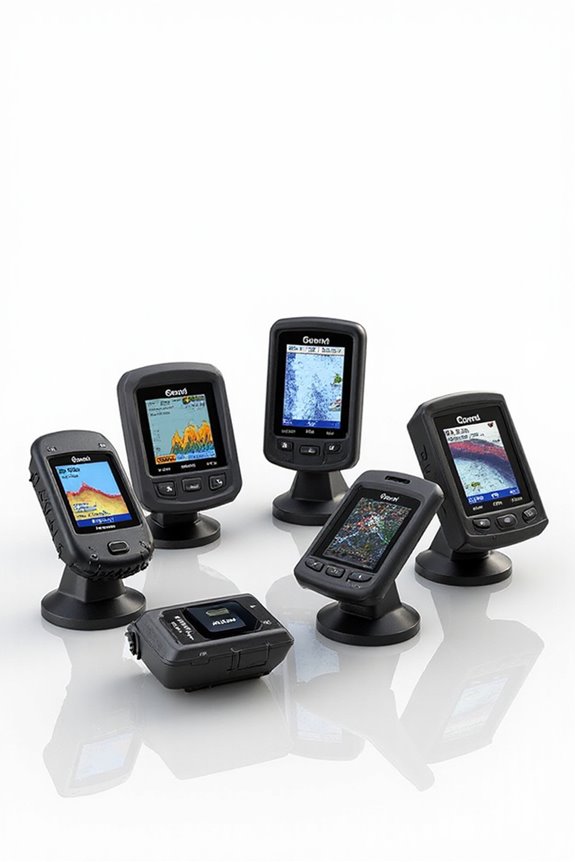As an Amazon Associate, we earn from qualifying purchases. Some links may be affiliate links at no extra cost to you. Although our opinions are based on curated research, we haven't used these products. Articles generated with AI.
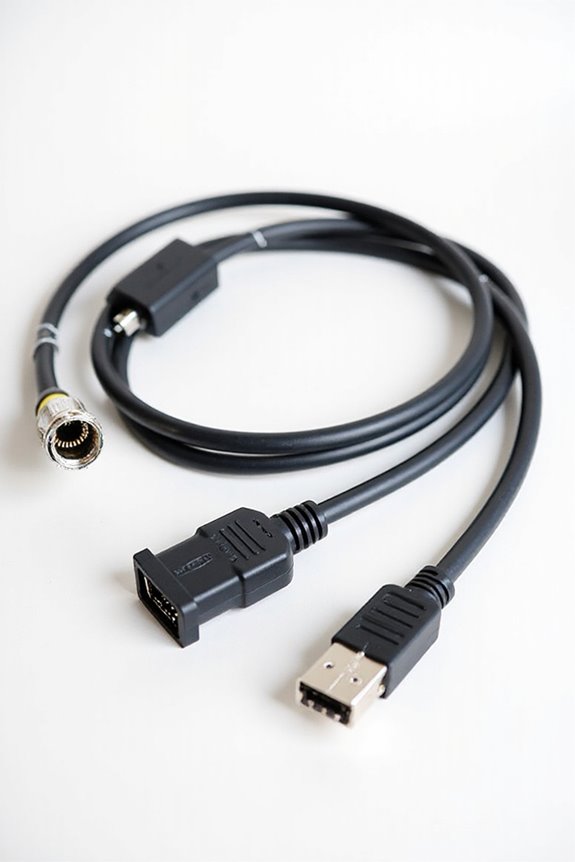
The 5 Best NMEA 2000 Backbone Cables for Reliable Marine Networking in 2025
Looking for the best NMEA 2000 backbone cables in 2025? Check out the 10 Foot Extension Cable for Lowrance, Simrad, B&G, and Garmin. The Marine Grade NMEA 2000 Starter Kit is another solid option for upgrading your setup. For versatility, try the Ancor 270002 2 Meter Cable or the Ancor 270001 0.5 Meter version for compact needs. Finally, the 1 Meter Drop or Extension Cable is great for connecting sensors. Stick around, and you’ll uncover more essential tips!
Key Takeaways
- The NMEA 2000 10 Foot Backbone Drop Cable is excellent for flexible connections among devices from brands like Lowrance, Simrad, and Garmin.
- A Marine Grade NMEA 2000 Starter Kit provides comprehensive components for those looking to upgrade their marine networking setup easily.
- The Ancor 270002 NMEA 2000 Backbone Cable – 2 Meter offers reliable networking solutions for moderate installation requirements in larger vessels.
- The Ancor 270001 NMEA 2000 Backbone Cable – .5 Meter is ideal for compact installations where space is limited, without compromising on performance.
- The NMEA 2000 Backbone Drop Cable (1 Meter) is perfect for connecting marine sensors or displays to an NMEA 2000 network efficiently.
NMEA 2000 10 Foot Backbone Drop or Extension Cable for Lowrance, Simrad, B&G, Garmin Networks
Regatta Processing NMEA 2000 (N2K) 10 Foot Backbone, Drop or Extension Cable for Lowrance Simrad B&G...
- 10 foot backbone/drop cable. Use for connecting sensors or displays to an NMEA 2000 network, or to extend the N2K backbone cable.
- NMEA 2000 Certified, 100 percent universal and compatible with other manufacturers' products.
- Black Cable (22AWG/2C and 24AWG/2C) shielded to reduce interference.
If you’re looking to enhance your marine networking setup, the NMEA 2000 10 Foot Backbone Drop or Extension Cable is your go-to choice, especially if you’re using devices from brands like Lowrance, Simrad, B&G, or Garmin. This 10-foot cable gives you ample length to connect your gear without feeling cramped, and it’s NMEA 2000 certified, ensuring universal compatibility. With shielded design to minimize interference and gold-plated contacts, you won’t just be “connected” — you’ll be connected smartly! Plus, it’s IP67 rated, which means it can handle a splash or two. Who knew connectivity could be this reliable?
Best For: The NMEA 2000 10 Foot Backbone Drop or Extension Cable is best for boaters and marine enthusiasts using equipment from Lowrance, Simrad, B&G, or Garmin looking to enhance their network connectivity.
Pros:
- NMEA 2000 certified, ensuring universal compatibility with various marine devices.
- 10-foot length provides flexibility in connecting devices without limitations.
- Shielded design reduces interference, while gold-plated contacts enhance corrosion resistance.
Cons:
- Limited to a 10-foot length, which may not be sufficient for larger setups.
- IP67 rating means it can only withstand submersion up to 1 meter for 24 hours, which may not be adequate for all marine environments.
- The use of gold-plated contacts may increase the cost compared to standard connectors.
Marine Grade NMEA 2000 Starter Kit for Lowrance, Simrad, Garmin Devices
EVRBUL Marine Grade NMEA 2000 Starter Kit, NMEA 2000 Backbone Cables Drop Cables Dual Tee Connector...
- 【Wide Compatibility】: This NMEA 2000 starter kit is compatible with Lowrance, Simrad, B&G, and Garmin devices, ensuring hassle - free connectivity across a wide range...
- 【Robust Construction】: Designed for unwavering reliability, our NMEA 2000 starter kit is made of high quality materials, specifically tailored to endure the punishing...
- 【Plug and Play】: Designed for intuitive installation, this NMEA 2000 starter kit comes with standardized connectors that fits effortlessly together. Whether you’re...
The Marine Grade NMEA 2000 Starter Kit is an ideal choice for boaters looking to create or upgrade their marine networks, especially if you own devices from Lowrance, Simrad, or Garmin. You’ll love how easy this kit makes installation with its plug-and-play design. Inside, you’ll find high-quality backbone and drop cables, plus a dual tee connector and terminators—all designed for durability in harsh marine conditions. These premium components mean minimal signal loss and seamless communication between your GPS, sonar, and engine monitors. Think of it as upgrading your boat’s brain—who doesn’t want a smarter vessel? Enjoy stress-free networking!
Best For: Boaters seeking to enhance their marine networking capabilities with reliable and easy-to-install NMEA 2000 components, particularly those using Lowrance, Simrad, or Garmin devices.
Pros:
- Easy Installation: Plug-and-play design ensures straightforward setup with standardized connectors.
- Durable Construction: High-quality materials provide resistance to abrasion and water, suitable for harsh marine environments.
- Optimized Performance: High-precision cables and calibrated terminators minimize signal loss and enhance data sharing between devices.
Cons:
- Weight Limitations: At 1.94 pounds, it may be heavier compared to some other networking options.
- Limited Compatibility: While compatible with popular brands, it may not support all marine electronic devices.
- Country of Origin: Manufactured in China, which may raise concerns for customers preferring locally sourced products.
Ancor 270002 NMEA 2000 Backbone Cable – 2 Meter
Sale
Ancor 270002 NMEA 2000 Backbone Cable - 2 Meter
- Color coded for easy installation and component identification
- Large 18 AWG power conductors to reduce voltage drop and provide better reliability for critical backbone cables
- NMEA 2000 Certified, 100 percent universal and compatible with other manufacturers' products
Looking to streamline your marine networking setup? The Ancor 270002 NMEA 2000 Backbone Cable, measuring a handy 2 meters, is perfect for the job. It’s NMEA 2000 certified, ensuring compatibility with a wide range of devices. Installation’s a breeze, thanks to color-coded features that match perfectly with Ancor tees. Plus, those large 18 AWG power conductors help reduce voltage drop, keeping your network reliable—like a trusty first mate! Who doesn’t want excellent performance on the water? If you’re looking for a solid backbone cable, this one’s hard to beat. Trust me; your marine networking experience will thank you!
Best For: Marine enthusiasts looking for a reliable and easy-to-install networking cable for their NMEA 2000 systems.
Pros:
- NMEA 2000 certified for universal compatibility with a variety of devices.
- Color-coded design simplifies installation and component identification.
- Large 18 AWG power conductors minimize voltage drop for enhanced reliability.
Cons:
- Length of 2 meters may not be sufficient for larger setups.
- Primarily designed for marine applications, limiting use in other environments.
- Higher gauge cables may be preferred by some users for specific setups.
Ancor 270001 NMEA 2000 Backbone Cable – .5 Meter
Sale
Ancor 270001 NMEA 2000 Backbone Cable - .5 Meter
- The yellow nuts connect to the corresponding Ancor tees creating a simplified, color coded network installation
- Color coded for easy installation and component identification
- Large 18 AWG power conductors to reduce voltage drop and provide better reliability for critical backbone cables
For those seeking a reliable backbone cable for their marine networking setup, the Ancor 270001 NMEA 2000 Backbone Cable offers a fantastic option at just 0.5 meters long. You’ll love the convenient yellow nuts, which color-code your connections and simplify installation. It’s like having a friendly guide for your network! With 18 AWG power conductors, this cable minimizes voltage drop, enhancing reliability where it matters most. Plus, it’s fully NMEA 2000 certified and compatible with other manufacturers’ products. Ever try connecting a dozen cables and figure out which one goes where? This one makes it much easier, trust me!
Best For: Those looking for a reliable and easy-to-install backbone cable for their NMEA 2000 marine networking needs.
Pros:
- Yellow nuts for color-coded connections simplify identification and installation.
- Large 18 AWG power conductors reduce voltage drop for enhanced reliability.
- Fully NMEA 2000 certified and compatible with products from other manufacturers.
Cons:
- Limited length of 0.5 meters may not suit larger installations without additional cables.
- May require additional components (like tees) for full network setup.
- Higher gauge may lead to less flexibility compared to thinner cables.
NMEA 2000 Backbone Drop or Extension Cable (1 Meter)
Regatta Processing NMEA 2000 (N2K) 1 Meter (3ft 3 inches), Backbone, Drop or Extension Cable for...
- 1 meter (3 ft 3 inches) backbone/drop/extension cable. Use for connecting to an NMEA 2000 network, or to extend the N2K backbone cable.
- NMEA 2000 Certified, 100 percent universal and compatible with other manufacturers' products
- Black Cable (22AWG/2C and 24AWG/2C) shielded to reduce interference.
Need a reliable way to connect your marine sensors or displays to an NMEA 2000 network? Check out the NMEA 2000 Backbone Drop or Extension Cable (1 Meter). This cable’s perfect for extending your N2K backbone or hooking up your gear, and it’s universally compatible—so, yes, it’ll play nice with Lowrance, Garmin, and more! With waterproof protection and sturdy 5-pin gold-plated connectors, it’s designed to withstand the elements. Plus, with a swift data transfer rate of 1 Gbps, your marine electronics will run smoothly. Who doesn’t want that kind of peace of mind? Plug-in and set sail with confidence!
Best For: Those looking to reliably connect marine sensors or displays to an NMEA 2000 network with compatibility across major manufacturers.
Pros:
- NMEA 2000 certified for universal compatibility with various brands like Lowrance and Garmin.
- Waterproof rating of IP67 ensures durability in harsh marine environments.
- High data transfer rate of 1 Gbps for seamless operation of marine electronics.
Cons:
- Limited to a 1-meter length which may require multiple cables for larger setups.
- Male-to-female connector configuration may not suit all applications without adapters.
- Primarily designed for marine use, limiting versatility in other environments.
Factors to Consider When Choosing Nmea 2000 Backbone Cable
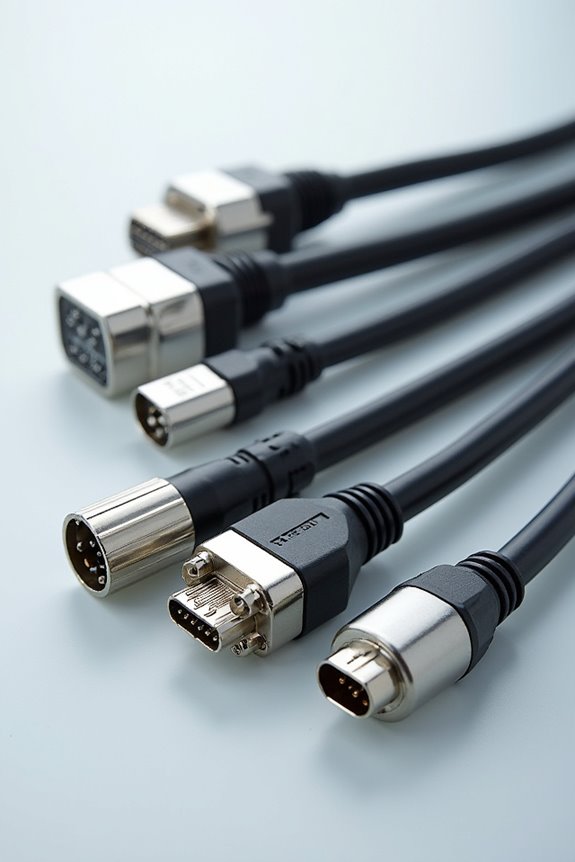
When you’re picking an NMEA 2000 backbone cable, there’s more to think about than just the price tag. You’ll want to ponder cable lengths that fit your setup, the right connector types, and how well it’ll work with your devices. Plus, don’t forget about durability because, let’s be honest, marine environments can be a bit unforgiving!
Cable Length Options
Choosing the right cable length for your NMEA 2000 backbone can feel a bit like Goldilocks and the Three Bears—too short and you’re left scrambling, too long and you’ve got a tangled mess. You’ll find options ranging from 0.5 meters to 10 feet, giving you flexibility for your marine setup. If your devices are close together, a 0.5-meter cable is perfect, keeping clutter at bay. However, for larger vessels where devices are spaced apart, a 10-foot cable lets you reach further while maintaining connection quality. Remember, longer cables can impact signal quality if they’re not rated properly. So, pick a length that fits your needs for ideal performance, ensuring compliance with NMEA 2000 standards. Happy sailing!
Connector Types Available
Now that you’ve got a handle on cable lengths, let’s shift gears and look at the connectors that make your NMEA 2000 backbone really tick. Most connectors sport 5-pin designs, ensuring reliable, standardized connections—because who wants a networking headache on their boat? Look for gold-plated contacts; they resist corrosion and enhance signal quality, which is a win-win! Color-coded connectors also make installation a breeze, letting you easily identify components. Plus, these connectors are designed for universal compatibility, so merging devices from different manufacturers isn’t a problem. And because they come with an impressive IP67 waterproof rating, you can trust them to perform even in the harshest marine conditions. Keep those connections solid and reliable!
Compatibility With Devices
Selecting the right NMEA 2000 backbone cable is essential if you want trouble-free device connectivity on your boat. Start by ensuring it’s NMEA 2000 Certified to guarantee universal compatibility—no one wants to play the guessing game with devices! Look for standardized 5-pin connectors; they make life easier by enhancing compatibility across various products. Also, consider cable gauge; larger gauge conductors can reduce voltage drop, which is a win for your critical backbone applications. Don’t forget about length—getting the right size matters for installation flexibility. Finally, make sure your cable’s designed for marine environments, as this keeps your devices functioning efficiently despite the salty air. After all, happy devices mean a happy captain, right?
Durability and Weather Resistance
When it comes to NMEA 2000 backbone cables, durability and weather resistance are key factors you can’t afford to overlook. You want cables with tough, waterproof sheathing that’s also abrasion-resistant, ready to brave those salty seas. Look for cables that are IP67 rated—yep, they’ll handle a little swim in up to 1 meter of water without batting an eye! Precision-crafted seals on connectors are essential; they stop annoying saltwater from creeping in and causing corrosion or connection failures. Plus, a shielded design is great for cutting down interference during those stormy days. Finally, opting for high-quality materials guarantees that these cables stick around for the long haul, whether you’re inside your cozy cabin or out on deck, soaking in the sun.
Installation Ease and Design
Installing NMEA 2000 backbone cables doesn’t have to feel like piecing together a jigsaw puzzle blindfolded. Look for cables with a plug-and-play design and standardized connectors—these features make installation a breeze, providing compatibility with various devices. Color-coded connectors help you avoid those “oops” moments, allowing easy identification during setup. Aim for backbone cables that connect directly to NMEA 2000 tee connectors for simpler network assembly. Plus, extensive installation kits often include extra bits like terminators and drop cables, ensuring you won’t be running to the store mid-project. Don’t forget marine-specific designs! Tough, waterproof sheathing protects against abrasion and relentless saltwater—just what your cables need for a long life on the water. Happy connecting!
Signal Quality and Interference
To guarantee your NMEA 2000 backbone cables deliver high-quality performance, you’ll want to pay close attention to signal quality and interference factors. High-precision cables with calibrated terminators help optimize signal transmission, reducing any pesky signal loss. You wouldn’t want your data sharing to be like a game of telephone, right? Look for shielded designs to minimize external interference—essential for reliable marine communication. Plus, gold-plated connectors resist corrosion, keeping your signal strong and clear, even after long periods at sea. Make sure the cables have an IP67 waterproof rating, too, because who knows when you might take an unscheduled plunge? Finally, larger gauge conductors like 18 AWG can reduce voltage drop, enhancing reliability for your backbone network.
Price and Warranty Considerations
Choosing the right NMEA 2000 backbone cable isn’t just about the quality of the signal; pricing and warranties play a big role, too! You’ll want to evaluate the price range, which can vary based on length, materials, and features like waterproofing. Comparing prices of cables with similar specs guarantees you’re getting the best bang for your buck—after all, nobody likes overpaying! Don’t forget to check warranty options; a longer warranty might just mean the manufacturer trusts their cable’s reliability. Also, keep an eye out for additional costs—like connectors or installation accessories—because those can sneak up on you! And of course, customer reviews can guide you like a trusty map when you’re maneuvering your options.
Frequently Asked Questions
How Do I Determine the Right Cable Length for My Setup?
Figuring out the right cable length for your marine setup feels like an Olympic sport—almost. Start by measuring the distance from your NMEA 2000 devices to your backbone, but don’t forget to account for any twists or turns in your layout. You also want a little extra length, so you’re not left with a tight fit, which typically calls for about 10% more. Trust me, nothing ruins a day on the water like tangled cables!
Can I Mix Brands of NMEA 2000 Cables?
Sure, you can mix brands of NMEA 2000 cables! They’re built to the same standards, so as long as they conform to NMEA 2000 specifications, you’re good to go. Just remember, not all cables are created equal. Some may perform better than others, but don’t worry—your network should function just fine. Just think of it like pairing socks; they don’t have to match perfectly to keep you warm!
What Is the Maximum Number of Devices per NMEA 2000 Network?
Think of your NMEA 2000 network like a bustling party. You can connect up to 50 devices, if you’re counting! This gives you plenty of room for essential gear like GPS, fish finders, and autopilots without overcrowding the room. Just remember, each device needs to play nice and follow the same rules. So, are you ready to throw the ultimate marine tech bash? Just make sure there’s enough bandwidth for everyone!
Are NMEA 2000 Cables Waterproof and Suitable for Marine Use?
Absolutely, NMEA 2000 cables are designed to be waterproof and perfectly suited for marine environments. They’re built to withstand moisture, salt, and the wear and tear that comes with life on the water. Just imagine this: you’ll have reliable communication for your devices even in the rain! However, always check the manufacturer’s specs to guarantee you’re getting quality cables. You don’t want your system to resemble last week’s soggy sandwich, right?
How Do I Troubleshoot Connectivity Issues in My NMEA 2000 Network?
If you’re facing connectivity issues in your NMEA 2000 network, start by checking the connections. Make sure everything’s plugged in tightly—loose cables can be sneaky! Next, inspect the cables for any damage. You wouldn’t believe how a tiny nick can cause big headaches. Finally, reboot your devices; it’s like giving them a little nap! If problems persist, you might want to consult your manual or consider a professional. Happy troubleshooting!





